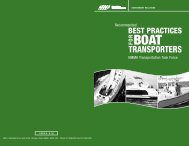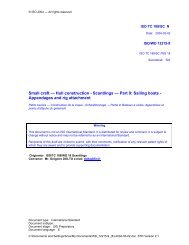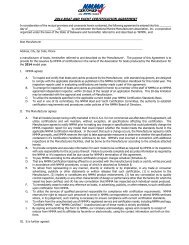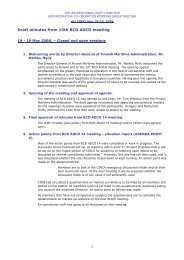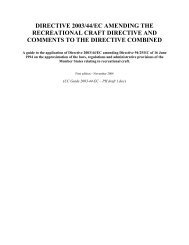Intellectual Property Protection and Enforcement Manual - Ipr-policy.eu
Intellectual Property Protection and Enforcement Manual - Ipr-policy.eu
Intellectual Property Protection and Enforcement Manual - Ipr-policy.eu
You also want an ePaper? Increase the reach of your titles
YUMPU automatically turns print PDFs into web optimized ePapers that Google loves.
Br<strong>and</strong> <strong>Protection</strong> <strong>Manual</strong><br />
motivated by greed <strong>and</strong> will move whatever products they can through their illicit chains of<br />
distribution. Indeed, whether it is knockoff designer h<strong>and</strong>bags or fake pharmac<strong>eu</strong>ticals, it does not<br />
matter to the counterfeiters—as long as there is a market for the product, they will manufacture <strong>and</strong><br />
sell it. Accordingly, every business is at risk.<br />
It is estimated that intellectual property theft costs domestic companies between $200 billion <strong>and</strong><br />
$250 billion a year 1 in lost revenues <strong>and</strong> has resulted in the loss of 750,000 jobs in the United<br />
States. 2 The harm caused by counterfeiting <strong>and</strong> piracy cannot be overstated. Every sale made by a<br />
counterfeiter is a sale that a legitimate business will never make. Because the counterfeiter is unlikely<br />
to have access to the same quality raw goods as the legitimate manufacturer <strong>and</strong> has no incentive to<br />
institute quality control practices or procedures, the resulting counterfeit product is most assuredly<br />
inferior in quality—<strong>and</strong>, in many instances, can be downright dangerous—compared to the<br />
legitimate product. As a result, an introduction into the market of a single counterfeit product has the<br />
potential to undermine <strong>and</strong> irrevocably damage years of building a business’ goodwill <strong>and</strong> reputation.<br />
To determine whether your business has a counterfeiting problem, you should ask the following<br />
questions:<br />
•<br />
•<br />
•<br />
•<br />
•<br />
•<br />
Do you have well-known or emerging br<strong>and</strong>s<br />
Have your br<strong>and</strong>s captured a significant share of the market<br />
Do you have a unique product that would be desired at a low price<br />
Are you experiencing an unexplained increase in returns or consumer complaints<br />
Are the reasons given for increased returns <strong>and</strong> complaints different than usual<br />
Have you lost market share in a particular region or regions<br />
If you answered “yes” to any or all of these questions, then someone, somewhere, is probably<br />
counterfeiting your product. If you are not sure, or need to better underst<strong>and</strong> the scope of your<br />
potential problem, you should (1) analyze your returns, complaints, <strong>and</strong> market share trends for<br />
anomalies; (2) interview key members of your sales, marketing, <strong>and</strong> quality assurance teams to obtain<br />
their firsth<strong>and</strong> impressions of the problems; (3) perform market surveillance—or “covert buys”—in<br />
areas that have suspicious decreases in market share or increases in customer dissatisfaction; (4) survey<br />
the Internet for sales of your product at suspiciously low prices <strong>and</strong> from unauthorized sources; <strong>and</strong><br />
(5) investigate markets that you have not yet entered, because if your br<strong>and</strong> name has market share<br />
where you are not even doing business, it is pretty clear that you have a problem.<br />
In short, any company with a well-known, valuable br<strong>and</strong> should assume that its br<strong>and</strong> is already<br />
being counterfeited. For companies lucky enough not to be victims, it is a question of when, not if.<br />
Accordingly, all businesses should develop <strong>and</strong> implement anti-counterfeiting <strong>and</strong> piracy strategies<br />
<strong>and</strong> build them into their everyday business practices. It should be made clear from the CEO level to<br />
Page 3



